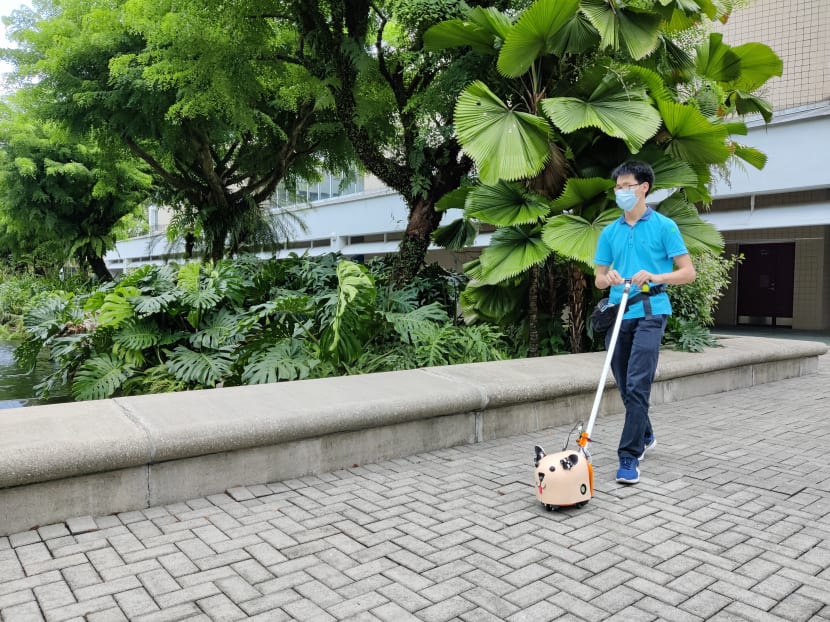Nanyang Polytechnic students develop robot guide dog on wheels to help vision impaired
SINGAPORE — A team of students at Nanyang Polytechnic (NYP) has developed a prototype robot dog for the visually impaired that reads out directions and even “barks” when an obstacle is ahead.
- The e-Guide Dog’s laser scanners tell when an obstacle is in the way
- It can give voice directions on a preset route
- The robot dog can also tell when a traffic light turns green
SINGAPORE — A team of students at Nanyang Polytechnic (NYP) has developed a prototype robot dog for the visually impaired that reads out directions and even “barks” when an obstacle is ahead.
Instead of a leash, a user holds onto a handle attached to the wheeled device and pushes it along the journey.
The “e-Guide Dog” is equipped with laser scanners that detect when an obstacle is in the way. It can also be programmed with preset routes that will give its user directions within a 1m level of accuracy.
The device is also fitted with a built-in digital compass, and uses data from encoders on the e-Guide Dog’s wheels, which monitor wheel revolutions and steering angles, to provide accurate locational guidance.
At a pedestrian crossing, the device can also tell when the traffic light turns green and alerts the user when to cross the road, using its onboard artificial intelligence technology.
It’s a role that guide dogs cannot perform, and a challenge that had particularly troubled Mr Dallon Au, 21, whose cataract left him with only partial vision in his left eye from birth.
“There are places where there’s no (audio) indicators to tell us when the light turns green,” said Mr Au, a third-year Infocomm and Security student from the NYP who had worked with the team to test the robot dog.
Mr Au has to be extra wary about crossing traffic junctions. At some, even when the traffic light beeps when it turns green, they are not enough to guide him. He must rely on the sounds of cars driving past as a cue on which way is safe to cross.
The e-Guide Dog was developed by a team of more than six NYP students across several semesters who were led by Dr Kong Wai Ming, lead specialist of the biomedical engineering and materials group at the polytechnic’s School of Engineering.
The project is backed by the Enabling Lives Initiative Grant by SG Enable, an agency that supports people with disabilities, and the Tote Board. The grant funds innovations that support persons with disabilities.
On Wednesday (May 5) morning, the project earned praise from Dr Maliki Osman, Second Minister for Education, during the polytechnic’s graduation ceremony.
In his speech, Dr Maliki said the project was an example of what NYP stands for — “innovation and enterprise, anchored in service to those around us”.
Even with his white cane, Mr Au has bumped into objects in public often enough.
“If there’s an object above the ground, like a sign board… we will walk into it, definitely,” he said.
The e-Guide Dog can detect such obstacles and will even alert users to oncoming cyclists. It does so by playing the sound of a dog barking — a feature expressly requested by Mr Au.
Guide dogs can also be expensive, costing upwards of S$50,000 to train, feed and care for.
During development, the team worked with Guide Dogs Singapore — the main charity in Singapore that pairs these canines with the visually impaired — to test the device.
The students have also adapted the robot dog’s technology to be fitted on a cane, which they showcased at an exhibition at the National Museum of Singapore last December.
Now, the team is seeking to improve its robot guide dog by working with industry partners and hopefully commercialise the project.
Mr Au said he hopes that future projects can help ease the major bugbears he faces when navigating in public: Recognising bus numbers and finding his way in shopping malls.
“These are some of the things that would make us more independent and we don’t have to keep asking other people for help,” he said.









